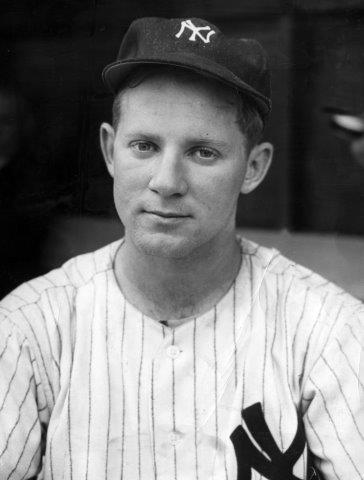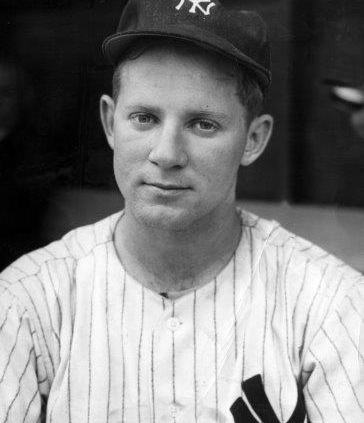August 12, 1953: Whitey Ford stars on the mound and at the plate as Yankees rout Senators, 22-1
 As the Yankees prepared to play the Washington Senators on the evening of August 12, 1953, they were firmly in first place with a six-game lead over the Chicago White Sox. The Senators were having what for them was a decent season with a record of 55-57, 19½ games behind the New Yorkers. The game was the second in a three-game series, with Casey Stengel managing the Yankees and Bucky Harris the Senators.
As the Yankees prepared to play the Washington Senators on the evening of August 12, 1953, they were firmly in first place with a six-game lead over the Chicago White Sox. The Senators were having what for them was a decent season with a record of 55-57, 19½ games behind the New Yorkers. The game was the second in a three-game series, with Casey Stengel managing the Yankees and Bucky Harris the Senators.
Stengel became the Yankees manager at the start of the 1949 season and won the World Series in each of his first four seasons. With the 1953 season winding down, New York was en route to another pennant that would lead them to their fifth World Series triumph in a row. No team before or since has ever won more consecutive World Series titles. The Senators were a long way from their glory days when Walter Johnson led them to a world championship in 1924. In the 1940s Washington finished last or next to last six times. The new decade was only slightly better as the 1950 squad finished fifth, as did the 1952 team, with the 1951 club finishing next to last. When fans spoke of Washington it was “first in war, first in peace and last in the American League.”1
The pitching matchup that evening was the Yankees ace left-hander, Whitey Ford (the Chairman of the Board) against an ex-Yankee, right-hander Frank “Spec” Shea. Coming into the contest, Washington hurlers had pitched seven consecutive complete games and had allowed a total of only 16 runs over their previous 12 games whiles averaging just 5.4 hits allowed per game over that stretch. Any chance of extending the consecutive complete-game streak evaporated quickly: Shea was rudely greeted by the Yankees in the top of the first. They scored four times in the frame, sending Shea to the showers after retiring only one batter. The Yankees had five hits in the inning, highlighted by a three-run home run by Yogi Berra. Berra’s blast was the only home run of the game and was the Yankees’ 100th homer of the season. It was the 30th time the Yankees had hit 100 or more home runs in a season, a record at the time.
The Yankees scored their 22 runs on 28 hits, the highest hit total of the season in the major leagues and only two shy of the then American League record. That record, of 30 hits in a game, was set by the Yankees themselves on September 28, 1923, in a 24-4 win over the Boston Red Sox. The 28 hits consisted of the Berra home run, two triples, three doubles, and 22 singles. The 22 runs scored were not the highest total in a 1953 game; that honor went to the Red Sox, who scored 23 against the Detroit Tigers on June 18.
After Shea took an early shower, the next three Senators pitchers fared no better. Al Sima gave up four runs in two innings of relief. He was followed by Sonny Dixon, who gave up five runs in 2⅔ innings. Finally, Jerry Lane was battered over the last four innings, allowing 10 runs and 13 hits. Senators pitchers walked seven and struck out only two.
Berra was the big hitter for the Yankees; the future Hall of Famer drove in five runs with his home run and a double. Left fielder Gene Woodling went 4-for-7, second baseman and future Yankees manager Billy Martin was 3-for-7 with a triple and five RBIs, third baseman Gil McDougald was 3-for-3, right fielder Hank Bauer scored five runs, and 1950 MVP (and future Hall of Famer) Phil Rizzuto was 2-for-2 with two RBIs. Ford got into the act as well, as the usually light-hitting pitcher (lifetime .173 batting average) went 4-for-5 with two RBIs. It was the second time in nine days that Ford had gone 4-for-5. He did it on August 3 against the St. Louis Browns.
Writing in the next day’s New York Times, John Drebinger noted that “there was one slightly discordant note that spoiled what otherwise would have been a perfect evening for the world champions.”2 Leading 22-0 in the eighth inning, the Yankees were poised to set a modern major-league record for the most runs scored in a shutout. But Stengel decided to take Ford out of the game after he had pitched four-hit-shutout ball over seven innings. With a 22-0 lead, Stengel figured he would give Ford a rest and took the opportunity to bring in 24-year-old Steve Kraly, a left-hander whom the Yankees had brought up from the minors three days earlier. Kraly finished the game, allowing one run, two hits, and four walks, as the shutout slipped away.3 As a result, the major-league record at the time for the largest margin of victory in a shutout remained 21-0, set by Detroit against Cleveland in 1901 and tied by the Yankees in their August 13, 1939, win against the Philadelphia Athletics.4
While Ford did not remain in the game to get the shutout, his performance both on the mound and at the plate led to some humorous remarks by Stengel. As recounted by Dan Daniel in The Sporting News, Stengel remarked, “[O]ur Mr. Whitey Ford expects me to give him the big A for effort and a bigger one for achievement that night we beat Washington by a mere 21-run margin. You will recollect that he gets four hits in five tries. He gets four hits in five tries the previous week, against the Tigers[sic]. He becomes hit crazy and, on that point, a little hard to handle.”5 Casey went on to say that he told Ford to bunt during the game against Washington because he didn’t want him running the bases, and Ford simply ignored him. Casey had a way of speaking, especially to the press, that was both funny and confusing at times, known in New York as Stengelese. Behind Stengel’s humor, and hard-to-parse language, was usually meaning. And in this case Stengel thanked Ford for “teaching my players a valuable lesson,” that “you don’t have to swing for the stands to hit. Just meet the ball.” It makes one wonder what Casey would be saying in the twenty-first century as batters swing for the fences with increasing frequency and contacting the baseball seems to be a lost art.
After their blowout victory, the Yankees beat the Senators again the next night, this time by a relatively tame 6-1 margin. New York then left the nation’s capital with a 75-36 record, and a seven-game lead over Chicago. The Yankees would go on to win 24 of their final 40 games and won the pennant, finishing 8½ games ahead of the Cleveland Indians. New York went on to beat the Brooklyn Dodgers and win the World Series for the fifth consecutive year.
Sources
In addition to the sources cited in the Notes, the author also consulted Baseball-Reference.com and Retrosheet.org.
Notes
1 Charles Dryden, Washington Post, June 27, 1904.
2 John Drebinger, “Ford Registers 14th Triumph 22-1 as Bombers Stage a 28-Hit Attack,” New York Times, August 13, 1953.
3 Kraly made three more appearances in the 1953 season and did not pitch in the major leagues again.
4 The August 13, 1939, game was considered for inclusion in this book. But with two 20-run-margin wins against the same Philadelphia team two months apart, on June 28 and August 13, the editors chose to include only one. Since the June 28 game was part of a 33-2 doubleheader sweep, and the August 13 game was part of a doubleheader in which the Yankees split, the choice was to include the June 28 game.
5 Dan Daniel, “Over the Fence by Dan Daniel, a Morning with Mr. Stengel,” The Sporting News, August 26, 1953: 12.
Additional Stats
New York Yankees 22
Washington Senators 1
Griffith Stadium
Washington, DC
Box Score + PBP:
Corrections? Additions?
If you can help us improve this game story, contact us.


